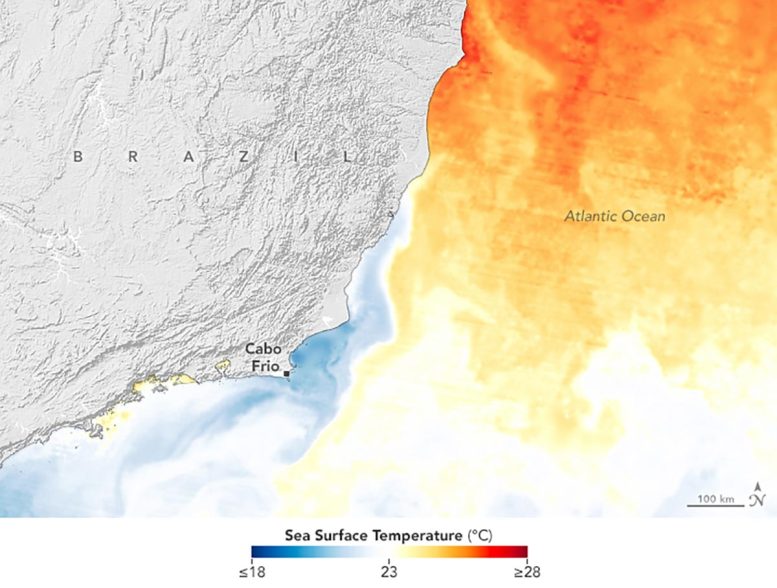Satellite image of Cabo Frio’s diverse coastline captured on September 16, 2023, by the Operational Land Imager-2 on Landsat 9.
People have long noticed that the waters around Cabo Frio are unusually cool.
When European explorers first surveyed the coastline of what is now the state of Rio de Janeiro in the early 1500s, they encountered white sands, turquoise waters, shallow lagoons, and lush green mountains rising from the sea. The waters in one area, however, were unusually cool—so much so that the promontory in southeastern Brazil shown above was named Cabo Frio, Portuguese for “Cape Cold.”
Landsat 9’s OLI-2 (Operational Land Imager-2) captured this image of Cabo Frio’s diverse coastline on September 16, 2023. The map (below) shows that surface waters that day were cooler off of Cabo Frio than in the surrounding waters. The pattern is common: Upwelling of cold water from deeper in the ocean to the surface often chills Cabo Frio’s surface waters by several degrees.
Data for the map come from MUR SST (Multiscale Ultrahigh Resolution Sea Surface Temperature), a temperature analysis from a team at NASA’s Jet Propulsion Laboratory. MUR SST blends measurements of sea surface temperatures from multiple NASA, NOAA, and international satellites, as well as ship and buoy observations. The terrain in the map is from a digital elevation model made with observations from the Shuttle Radar Topography Mission (SRTM).
The Forces Behind Cabo Frio’s Unique Climate
The upwelling is primarily caused by the prevailing winds. Strong northeasterly winds that blow along the coast for much of the year—especially in the spring and summer—push warm surface waters away from the shore. This allows cool waters from deeper in the ocean to rise to the surface. Upwelled water is typically rich in nutrients that fuel populations of phytoplankton, which in turn nourish marine ecosystems and contribute to Cabo Frio’s productive fisheries.
One model of Cabo Frio upwelling, developed by researchers in Germany and Brazil, indicates that the zone of cool water typically covers an area about 200 kilometers long and 20 kilometers wide (124 miles long and 12 miles wide), and has temperature gradients as large as 8 degrees Celsius (14 degrees Fahrenheit) over less than 10 kilometers. The findings were based in part on wind speed measurements from NASA’s QuikSCAT satellite that were incorporated into the analysis.
The first known use of the name “Cabo Frio” appears on Kunstmann III, the oldest known nautical chart that includes lines of latitude. The map, which dates to 1506 or possibly earlier, is thought to be based partly on expeditions to South America led by the Portuguese explorer Gonçalo Coelho and Italian navigator Amerigo Vespucci.
NASA Earth Observatory images by Lauren Dauphin, using Landsat data from the U.S. Geological Survey and data from the Multiscale Ultrahigh Resolution (MUR) project.






